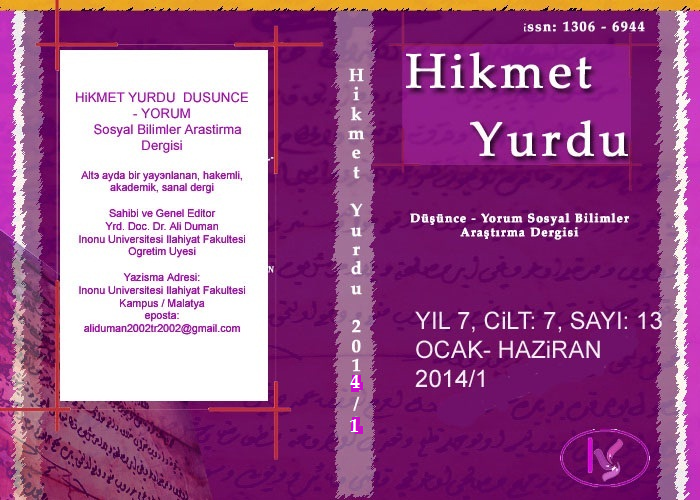Author :
Abstract
XI. yüzyıldan itibaren Türk göçlerine sahne olan Anadolu'da Selçuklular gerçekleştirdikleri mimari eserler ve kurumlarla Anadolu kültürünün kaynaşmasını ve halkın ihtiyaçlarının giderilmesini amaç edinmişlerdir. Bu eserler arasında halkın hizmetine sunulan mabet, medrese, mektep, imaret, zaviye, kütüphane ve darü'ş-şifalar gibi vakıf kurumlarını sayabiliriz. Darü'ş-şifalar, temelde, birer kamusal hayır kurumu olarak tesis edilen hastanelerdir ve en çarpıcı özellikleri bu hastanelerde hastaların tıbbi bakımlarının ve tedavilerinin parasız yapılmış olmasıdır. Bu yönüyle özel olarak darü'ş-şifalar, genel olarak tüm vakıf eserleri sosyal devlet anlayışının bir tür öncüsü olarak değerlendirilebilir.
Keywords
Abstract
In Anatolia, as of the 16th century, that witnessed several Turkish migrations, the Seljuk aimed to provide the necessities for the people and to merge the different Anatolian cultures with the help and functions of some architectural works and institutions. Among these works, we can state some charity foundations all rendered for the use of the public such as temples, madrasahs, schools, dervish lodges, libraries, alms houses and cottage houses. Being, in essence, public charity hospitals, the most important aspect of the cottage houses is the fact that they provided free medical care and cure services for the people. In this respect, the cottage houses in particular and all kinds of charity works in general can be regarded as a pioneer for the formation of social state understanding.
Keywords
- ACIDUMAN, Ahmet, (2010), Dârü’ş-şifalar Bağlamında Kitabeler, Vakıf Kayıtları ve Tıp Tarihi Açısından Önemleri - Anadolu Selçuklu Dârü’ş-şifaları Özelinde, Ankara Üniversitesi Tıp Fakültesi Mecmuası, Cilt: 63 Sayı: 1, s. 9-15.
- ARDIÇOĞLU N , (1964), Harput Tarihi, İstanbul.
- AYDIN, Erdem, (1997), “Anadolu’daki Ticaret Yolları ve Sağlık Hizmetleri”, Yeni Tıp Tarihi Araştırmaları, S.2-3, İstanbul, s.165.
- BAŞAR, Zeki, (1971), “Harput Maristanı”, Dirim Dergisi, C. XLVI, S. 9, İstanbul, s.32
- BAYAT, A.H, (2001), "Anadolu'da Selçuklu Dönemi Dârü’ş-şifaları Üzerine Toplu Değerlendir- me", I. Uluslararası Selçuklu Kültür ve Medeniyeti Kongresi Bildirileri-I, Selçuk Üniversitesi, Selçuklu Araştırmaları Merkezi Konya, s. 121-148.
- BAYAT, A.H, (2002), Kayseri Gevher Nesibe Tıp Medresesi ve Maristanı, Editör Sarı N. Ülker Erke’nin Yorumu ve Fırçasıyla Türkiye’de Tarihi Sağlık Kurumları, İstanbul.
- BAYAT, A.H, (2003), Tıp Tarihi, İzmir.
- CANTAY, G, (1992), Anadolu Selçuklu ve Osmanlı Dârü’ş-şifaları, Ankara.
- CANTAY, G, (1994), “Türklerde Vakıf ve Taş Vakfiyeler”, XI. Vakıf Haftası Kitabı, Vakıflar Genel Müdürlüğü, Ankara.
- CANTAY, G, (1998), Kadın Baniler ve Dârü’ş-şifalar, Editör N Yıldırım, Sağlık Alanında Türk Kadını, İstanbul.
- DEMİR, Mustafa, (2002), “Türkiye Selçuklu Vakıfları”, Türkler, C.7, Yeni Türkiye Yayınları, Ankara, s.275.
- DEMİRALP, Yekta, (1996), Akşehir ve Köylerindeki Türk Anıtları, Ankara. Eravşar O, editör. I. Uluslararası Selçuklu Kültür ve Medeniyeti Kongresi, Bildirler, II. Cilt. Konya: Selçuk Üniversitesi Selçuklu Araştırmaları Merkezi, 2001, s. 121-148.
- ERKAN M., ŞAHİN, S, (1982), Türklerde Müzikle Ruh Ve Sinir Hastalıklarının Tedavisi, Kayseri Üniversitesi Gevher Nesibe Bilim Haftası Ve Tıp Günleri, Kayseri 11 – 13 Mart, s.572579.
- İNAN, Afet, (1969), Kayseri Gevher Nesibe Şifaiyesi, Hacettepe Üniversitesi Yayınları, Ankara.
- KADIOĞLU, Funda Gülay - Kadıoğlu, Selim, (2011), Adı Dârü’ş-şifalara Ad Olan Kadınlar, Lokman Hekim Journal of History of Medicine and Folk Medicine, Vol 1, No 1, s.1-7.
- KAYAOĞLU, İsmet, (1978), “Vakfiyenin Değerlendirilmesi”, Divriği Ulu Camii ve. Dârü’ş- şifası, (Editör: Y.Önge-İ.Ateş-S.Bayram), Ankara.
- KAZANCIGİL, A., (1993), Osmanlılar’da Bilim ve Teknoloji, Osmanlı Ansiklopedisi. Editör B Şahin. İstanbul, Cilt: 7, s.109-113.
- KEMALOĞLU, Muhammet, (2013), XI.-XIII. Yüzyıl Türkiye Selçuklu Devletinde Dini Eserlerin- den Kümbet-Türbe-Ziyâretgâh-Namazgâh ve Câmîler, Akademik Bakış Dergisi, Sayı: 39, Kasım-Aralık, s.1-18.
- KONYALI, İ.H, (1964), Abideleri ve Kitabeleri ile Konya Tarihi, Konya.
- KONYALI, İbrahim Hakkı, (1964-1997), Abideleri ve Kitabeleri ile Konya Tarihi, İstanbul.
- KONYALI, İbrahim Hakkı,(1997), Konya Tarihi, Burak Matbaası, Ankara
- KÜÇÜKDAĞ, Yusuf, (2010),“ Belgelerle Adım Adım Eski Konya”, Merhaba Akademik Sayfalar, Cilt: 10 Sayı: 13,14 Nisan,s.193.
- ÖNGE,Y., (1962), Çankırı Dârü’ş-şifası, Vakıflar Dergisi, Cilt: 5, s.251-255.
- SAMUR, Tahsin, (1997),Akşehir’deki Türk Mimari Eserleri, İstanbul.
- SUNGUROĞLU, İshak, (1958), Harput Yollarında, C.I, İstanbul.
- TERZİOĞLU, Arslan, (1970), Orta çağ İslâm-Türk Hastaneleri ve Avrupa'ya Tesirleri, Belleten, XXXIV/2, s.121-149
- TURAN, Osman, (1946), ″Selçuklu Kervansarayları″, Belleten: X/39, s. 471-496.
- TURAN, Osman, (1948), Celâleddin Karatay, Vakıfları ve Vakfiyeleri”, in: Belleten, XII/45, S. 17- 170.
- TURAN, Osman, (1987), Selçuklular Zamanında Türkiye, İstanbul.
- ÜNVER, Ahmet Süheyl, (1975), “Anadolu Selçuklu Laik Hastaneleri ve Ruh Sağlığı Hizmetle- ri”, Selçuklu Araştırmaları Dergisi, S. 4, Ankara, s.209
- YETKİN, Ş., (1963), Anadolu’da Selçuklu Şifahaneleri, Türk Kültürü, (10): 23-31.
- YİNANÇ, Refet, (1991), “Sivas Abideleri ve Vakıfları”, Vakıflar Dergisi, XXII, s.15-44.
- YOSKA Erhan, (2005), Türkiye Selçuklularında XIII. Yüzyıldaki Tıbbi Gelişmeler, Kayseri, EÜ Sosyal Bilimler Enstitüsü (Yüksek Lisans. Tezi)
- YÜKSEL, H, (2006), Anadolu Selçuklularında Vakıflar, Anadolu Selçukluları ve Beylikleri Dö- nemi Uygarlığı I.Editör A Yaşar. TC Kültür ve Turizm Bakanlığı Yayınları, Ankara, s.309
